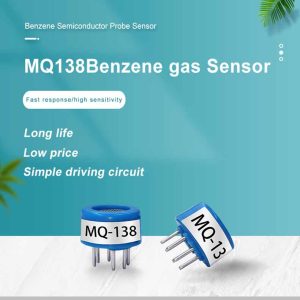Air pollution is a pressing global issue that poses significant risks to human health, the environment, and overall well-being. To tackle this challenge effectively, it is essential to have reliable tools and technologies for monitoring and combating air pollution. Gas sensors play a crucial role in this regard, enabling us to detect, measure, and analyze pollutant gases in the atmosphere. In this article, we will explore how gas sensors help combat air pollution and contribute to creating cleaner and healthier environments.

Real-time Monitoring:
Gas sensors provide real-time monitoring of pollutant gases, allowing for immediate detection and measurement. This capability is vital for identifying pollution sources, assessing their impact, and implementing timely mitigation strategies. Real-time data from gas sensors assists environmental agencies, researchers, and policymakers in making informed decisions and taking prompt actions to combat air pollution effectively.
Identification of Pollutants:
Gas sensors are equipped to detect various pollutants, including carbon monoxide (CO), nitrogen dioxide (NO2), sulfur dioxide (SO2), ozone (O3), volatile organic compounds (VOCs), and particulate matter (PM). By accurately identifying the presence and concentration levels of these pollutants, gas sensors offer valuable insights into the types and sources of air pollution. This information aids in targeting specific pollutants and designing appropriate control measures.
Source Apportionment:
Gas sensors contribute to source apportionment studies, which involve identifying the major contributors to air pollution in a given area or region. By measuring pollutant concentrations at different locations simultaneously, gas sensors help determine the sources of emissions, such as industrial plants, vehicles, or residential areas. This knowledge enables policymakers to prioritize mitigation efforts and implement targeted measures to reduce pollution from specific sources.
Compliance Monitoring:
Gas sensors play a crucial role in monitoring compliance with air quality regulations and standards. Industries and facilities subject to emission limits can utilize gas sensors to measure and track pollutant levels, ensuring adherence to the prescribed limits. Continuous monitoring with gas sensors helps identify any deviations from the standards, prompting necessary corrective actions and preventing excessive pollution.
Early Warning Systems:
Gas sensors are instrumental in developing early warning systems for air pollution events. These systems rely on the rapid detection of increased pollutant concentrations, which can indicate forest fires, industrial accidents, or other hazardous incidents. By triggering alerts and emergency response measures, gas sensors help mitigate the adverse effects of such events, protecting public health and minimizing environmental damage.
Environmental Impact Assessments:
Gas sensors facilitate environmental impact assessments by providing accurate and reliable data on air pollution levels. Before initiating new projects or activities with potential environmental implications, gas sensors can be deployed to measure baseline pollution levels. Subsequent monitoring enables the evaluation of the project's impact on air quality, ensuring that necessary mitigation measures are implemented to minimize pollution.
Urban Planning and Policy Formulation:
The deployment of gas sensors in urban areas aids in urban planning and policy formulation for air pollution control. By collecting data on pollutant concentrations across different neighborhoods and districts, gas sensors contribute to the mapping of pollution hotspots and identifying areas with poor air quality. This information guides urban planners and policymakers in developing effective land-use plans, implementing pollution control measures, and promoting sustainable urban development.
Citizen Engagement and Awareness:
Gas sensors enable citizen engagement and awareness regarding air pollution. Portable and wearable gas sensors allow individuals to monitor their personal exposure to pollutants, empowering them to make informed decisions about their activities and locations. Additionally, gas sensor networks can engage citizens in large-scale air quality monitoring initiatives, fostering a sense of ownership and collective responsibility in combating air pollution.
Technological Advancements:
Advancements in gas sensor technology have improved their accuracy, sensitivity, and portability. Miniaturized gas sensors and their integration into Internet of Things (IoT) platforms have made it possible to create comprehensive air quality monitoring networks. These networks facilitate real-time data collection, analysis, and visualization, enabling efficient decision-making and promoting effective pollution control strategies.

Conclusion:
Gas sensors are indispensable tools in the fight against air pollution. Their ability to detect, measure, and analyze pollutant gases in real-time helps in identifying pollution sources, guiding mitigation efforts, and assessing the effectiveness of pollution control measures. Gas sensors contribute to compliance monitoring, early warning systems, source apportionment studies, and environmental impact assessments. Moreover, gas sensors empower individuals and communities to actively engage in air quality monitoring and promote awareness about the importance of combating air pollution for a healthier and sustainable future. Continued advancements in gas sensor technology will further enhance our ability to combat air pollution effectively and create cleaner environments for generations to come.
 : +86 155 8830 2704
: +86 155 8830 2704 : jxdziot@gmail.com
: jxdziot@gmail.com
